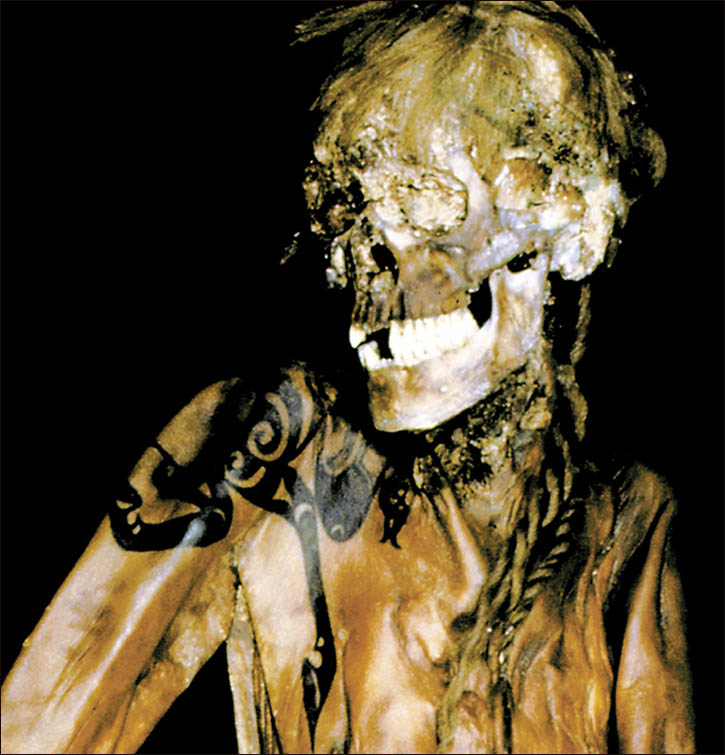http://www.scientificfund.kz/index....thropology-of-kazakh-people-and-their-genesis
Bronze Age Andronovo Culture in the area of modern Southern Russia and Kazakhstan were mostly light-haired (brown or blond) and blue- or green-eyed people:
Individuals with probably blond hair were identified at archaeological sites of Oust-Abakansty (Khakassia Republic, Russia) and Solenoozernaïa IV (Krasnoyarsk Region, Russia). They died around 1800 BC - 1400 BC and belonged to Andronovo Culture. Their skin pigmentation was identified as fair or medium and their eyes as blue or green. Their hair was blond. Two other individuals from the same burial site at Solenoozernaïa IV were identified as having brown hair - one of them had brown eyes and fair or medium skin. Another individual from Andronovo Culture - found at Tatarka cemetery (Charypovsky Region, Russia) - was identified as fair or medium skin, dark brown hair and brown eyes. Two individuals of Karasuk Culture, 1400 BC - 800 BC (Oust-Abakansty and Bogratsky, both in Khakassia) were blue or green eyed:
http://www.ancestraljourneys.org/autosomaladna.shtml#pigmentation
This guy died around 1010 BC:
http://www.ancestraljourneys.org/ancientdna.shtml
Mongolia - Takhilgat Uzuur-5 [TU34] - Dark blond/brown hair; brown eyes - Male - R1a1a1b2-Z93
http://en.wikipedia.org/wiki/Andronovo_culture#Ancient_DNA
Out of 10 human male remains assigned to the Andronovo horizon from the Krasnoyarsk region, 9 possessed the R1a Y-chromosome haplogroup and one the haplogroup C-M130 (xC3). mtDNA haplogroups of nine individuals assigned to the same Andronovo horizon and region were as follows: U4 (2 individuals), U2e, U5a1, Z, T1, T4, H, and K2b.
90% of the Bronze Age period mtDNA haplogroups were of west Eurasian origin and the study determined that at least 60% of the individuals overall (out of the 26 Bronze and Iron Age human remains' samples of the study that could be tested) had light hair and blue or green eyes.[19]
A 2004 study also established that, during the Bronze/Iron Age period, the majority of the population of Kazakhstan (part of the Andronovo culture during Bronze Age), was of west Eurasian origin (with mtDNA haplogroups such as U, H, HV, T, I and W), and that prior to the thirteenth to seventh century BC, all Kazakh samples belonged to European lineages.[20]
So were their R1a haplogroup IE Scythian descendants from Tuva Republic, Western Mongolia, during the Bronze Age and the Iron Age.
Some of IE Tocharians (Tarim mummies), on the other hand, appear to be red-haired.
Caucasoids extended as far east as Mongolia and Xinjiang (China) during the Bronze Age, as evidenced by Tocharian and Scythian remains.
Yellow = Eurasian steppe, red is area of Tocharians and north of them lived Bronze Age and Iron Age (Pazyryk Culture) Scythians:
Photos of Bronze Age IE mummies from Kazakh-Russian-Mongolian-Chinese borderlands:
Burial of an individual with Caucasoid features, dark blond hair and R1a haplogroup was discovered at Takhilgat Uzuur-5, Mongolia.
Also in Tuva Republic, near Russian-Mongolian border, there were kurgan burials of Scythians, including this one:
Red-haired Tocharian mummies from Xinjiang:
Two other Tocharian mummies from Xinjiang, Takla Makan Desert, Western China:
Blond Scythian guy from Arzhan, Afghanistan, near the Russian border (near Tuva Republic):
Indo-European Caucasoid mummy, buried in Issyk Kul Province of Kyrgyzstan (capital city is Karakol):
Red-haired Indo-European and Caucasoid mummy from Cherchen region in Western China:
Reconstruction of that female mummy from Cherchen:
Cherchen, Xinjiang province of China - face from painted clothes of one of Indo-European mummies:
Scythian art from Ukok Plateau - Pazyryk Culture:
http://en.wikipedia.org/wiki/Pazyryk_burials
Scythian Ukok Princess - she was buried together with two men, in the Ukok Plateau (border between Russia-China-Mongolia):
http://artislimited.wordpress.com/2...ill-be-displayed-publicly-for-the-first-time/
PDF article to download about Scythians of Pazyryk Culture:
http://www.google.pl/url?sa=t&rct=j...7CFSJRqfY-SmCLi_LIBRKig&bvm=bv.74115972,d.d2s
Western Mongolia was the area of a melting pot between Western Eurasian and East Asian populations during the Bronze Age:
http://forwhattheywereweare.blogspot.com/2014/06/west-east-admixture-in-mongolian-altai.html
http://www.fsigenetics.com/article/S1872-4973(14)00116-1/abstract
West-East admixture in Mongolian Altai in the Bronze Age
(...)
In the same way, the patrilineal gene pool revealed the presence of different haplogroups (Q1a2a1-L54, R1a1a1b2-Z93 and C), probably marking different origins for the male paternal lineages. To go further in the search of the origin of these ancient specimens, phenotypical characters (i.e. hair and eye color) were determined. For this purpose, we adapted the HIrisPlex assay recently described to MALDI-TOF mass spectrometry. In addition, some ancestry informative markers were analyzed with this assay. The results revealed mixed phenotypes among this group confirming the probable admixed ancestry of the studied Altaian population at the Middle Bronze Age.
Scythians of
Tuva Republic:
http://en.wikipedia.org/wiki/History_of_Tuva#Early_history
Iron Age Satem Indo-European Pazyryk Culture:
http://en.wikipedia.org/wiki/Pazyryk_culture
============================================
Map:
http://s29.postimg.org/fbpcibyef/Bronze_Age_IE_extent.png















